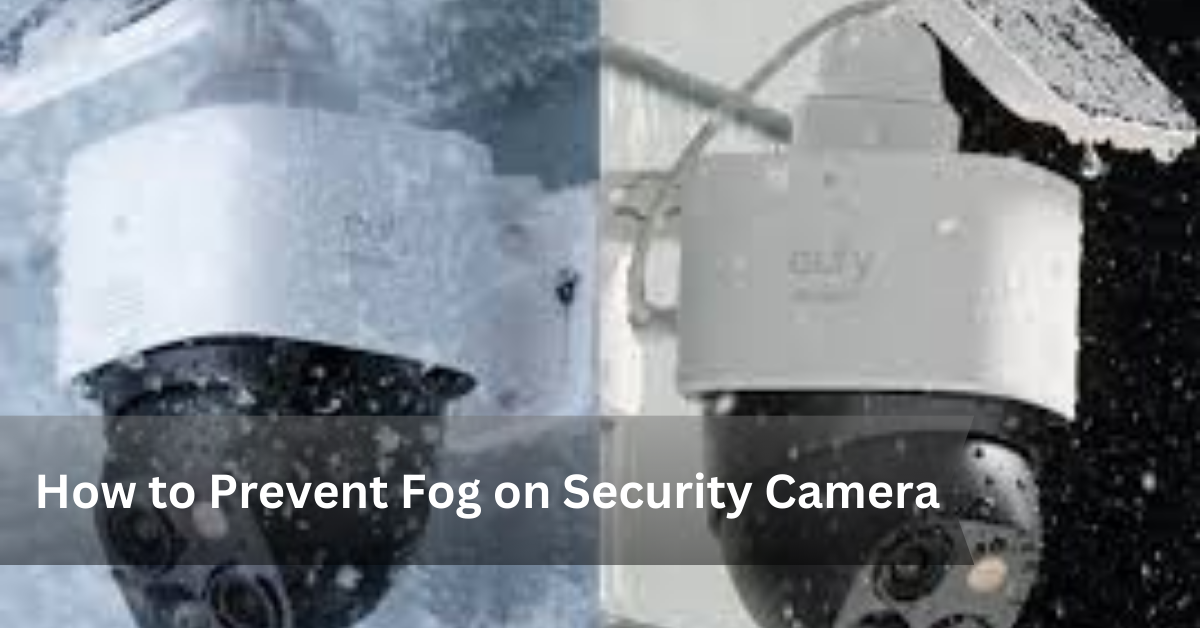Ever noticed fog obstructing your security camera’s view? Here’s how you can prevent it and keep your surveillance crystal clear, no matter the weather.”
Fog on security cameras can be a frustrating and disruptive issue, especially for outdoor cameras exposed to various weather conditions. The formation of fog occurs when moisture from humidity or sudden temperature fluctuations condenses on the camera lens, making it difficult to capture clear footage.
Clear surveillance footage is vital for maintaining security around your property. Foggy lenses can block important visual details, making it harder to identify intruders or capture key events. This issue not only undermines the purpose of your security cameras but also poses potential risks to your safety and property.
Therefore, finding effective ways to how to prevent fog on Security Camera crucial in ensuring the reliability of your security system.
In this guide, you’ll learn practical methods to keep your security cameras fog-free.
Common Causes of Fog on Security Cameras
Fog on security cameras is a common problem, particularly for outdoor surveillance systems. Understanding the factors that contribute to fog formation can help you take the necessary precautions to prevent it. These issues are primarily related to environmental conditions, the type of camera used, and its placement.
Environmental Factors
- Outdoor temperature fluctuations:
When the temperature changes suddenly, such as during the transition from day to night, it can create a temperature differential between the camera lens and the surrounding air. This can lead to condensation forming on the lens, resulting in foggy footage. For example, in cooler climates, cameras that are exposed to outdoor elements during the day may experience fog as temperatures drop in the evening.
- Humidity and dew point changes:
High humidity, particularly in areas with a large amount of moisture in the air, is another key contributor to fog formation. As the air cools, the moisture condenses, forming droplets on the camera lens. This is especially noticeable in areas where there is a significant dew point difference, such as during the early morning hours or in regions with frequent rain or fog.
Camera Type and Placement
- Issues with outdoor vs. indoor cameras:
Outdoor cameras are more susceptible to fogging because they are exposed to varying weather conditions, including rain, snow, and fluctuating temperatures. Indoor cameras, on the other hand, are typically less affected by environmental changes but can still experience fogging if placed near heat sources or in areas with high humidity, like bathrooms.
- How improper placement contributes to fog formation:
Cameras placed in locations where they are directly exposed to rapid temperature changes (such as near an air conditioning vent, heating unit, or an area that gets direct sunlight) are more likely to experience fog. Additionally, cameras that are improperly sealed or lack proper weatherproofing can be prone to fogging, especially when moisture infiltrates the casing.
How to Prevent Fog on Security Cameras
Fog on security cameras can obstruct your surveillance footage, rendering your system less effective. Luckily, there are several preventive measures you can take to keep your cameras clear of fog, regardless of weather conditions.
Anti-Fog Camera Covers and Filters
Anti-fog covers and filters are designed to prevent condensation from forming on the camera lens. Silicone gel packs can be placed inside camera enclosures to absorb moisture, while anti-fog filters are directly placed on the camera lens to keep the surface clear. These solutions are cost-effective and can be easily implemented, providing an immediate fix to the fogging issue.
Pros & Cons:
- Pros: Quick and easy to install, cost-effective, and can be replaced if needed.
- Cons: These solutions are not always long-term and may require frequent replacements, especially in areas with high humidity or extreme temperature changes.
Weatherproofing Your Camera
- Using Waterproof Casings to Keep Moisture Out:
Waterproof casings or enclosures are one of the best ways to prevent fog from forming inside the camera. By keeping the camera sealed and free from external moisture, you minimize the risk of condensation. These enclosures are typically weatherproof and can withstand rain, snow, and temperature fluctuations. - Sealing Gaps and Maintaining Camera Enclosures:
Ensuring that there are no gaps or cracks in the camera housing is crucial for preventing moisture from entering. Regularly inspect your camera enclosure and seal any potential entry points where moisture or air can get in. Proper sealing ensures that the internal environment of the camera remains dry and protected from fog-inducing humidity.
Proper Camera Placement
- How to Choose the Right Spot (Out of Direct Sunlight, Ventilation Considerations, etc.):
When placing your security camera, avoid areas where it is exposed to extreme temperature shifts. Direct sunlight can cause heat buildup, while placing a camera too close to heat sources like air conditioning vents or heaters may result in condensation. Look for spots that offer natural ventilation, allowing the camera to acclimate to the surrounding temperature. - Elevation and Angling Tips for Optimal Protection:
Mounting your camera higher up can help avoid moisture buildup at the lens, as condensation tends to collect at lower points. Additionally, angling your camera slightly downward can help minimize direct exposure to rain and snow, reducing the chances of fog formation. Ensure that the lens faces away from direct wind and precipitation,
Use of Dehumidifiers or Heating Elements
- Installing a Small Dehumidifier or Heating Unit Inside Camera Enclosures:
A dehumidifier can be placed inside the camera enclosure to reduce the moisture levels and prevent fog from forming. Additionally, heating elements can be used to maintain a consistent temperature inside the casing, ensuring that the camera stays warm enough to prevent condensation. - Pros & Cons:
- Pros: Highly effective for maintaining clear, moisture-free camera footage. This method works well in humid environments or areas with large temperature swings.
- Cons: Dehumidifiers and heating elements may require more maintenance, including regular checks to ensure they are functioning correctly. Also, these solutions can increase the energy consumption of the system.
Long-Term Solutions for Preventing Fog
Install a Dehumidification System
- How to Integrate a Dehumidifier with Your Surveillance Setup:
To ensure a dry environment for your security camera, a dehumidifier can be strategically placed in the camera’s housing or the room housing the camera. This will lower the humidity level inside the camera casing, preventing moisture buildup on the lens and internal components. Some systems are specifically designed to work in conjunction with security camera setups, offering a seamless solution. - Cost vs. Benefit Analysis:
The cost of installing a dehumidifier can range from $50 to $200 depending on the size and complexity of the system. While more expensive than quick fixes like anti-fog filters, dehumidifiers offer a more permanent and effective solution, particularly in areas with high humidity. The benefits far outweigh the cost when you consider that it will help prolong the life of your cameras and improve the quality of your footage, especially in climates prone to frequent fog.
Choosing the Right Security Camera for All Conditions
- Overview of Cameras with Built-In Fog-Resistant Technology:
Some modern security cameras come with built-in features designed to resist fog and condensation. These cameras are equipped with specially designed enclosures, lenses with anti-fog coatings, and internal heating elements to prevent condensation from forming. They are ideal for locations with extreme weather conditions. - Recommended Brands:
- Ring: Known for its high-quality outdoor cameras, Ring offers weather-resistant models that are equipped to handle fog, rain, and snow.
- Arlo: Arlo offers cameras with advanced weatherproof designs and features like temperature control, making them suitable for all seasons.
- Nest: Google’s Nest cameras feature all-weather protection and have received positive reviews for their ability to withstand environmental factors like humidity and fog.
Best Weatherproof and High-Quality Security Cameras
When it comes to outdoor surveillance, weatherproof cameras are essential for ensuring consistent, clear footage regardless of weather conditions. Here are some of the best weatherproof and high-quality security cameras to consider:
1. Ring Stick Up Cam Battery

- Key Features:
- 1080p HD video
- Two-way audio
- Motion detection alerts
- Works with Alexa
- Weather-resistant design (IP65 rating)
- Best For: Homeowners looking for an easy-to-install, versatile camera that works in all weather conditions.
- Price Range: $99 – $199
2. Arlo Pro 4
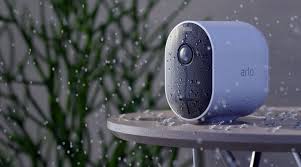
- Key Features:
- 2K video resolution with HDR
- Color night vision
- Integrated spotlight
- Weather-resistant (IP65 rating)
- Wire-free setup
- Best For: Users looking for a premium, high-definition security camera that works well in harsh outdoor environments.
- Price Range: $179 – $229
3. Nest Cam (Battery)

- Key Features:
- 1080p HD video
- Built-in Google Assistant support
- Motion and sound alerts
- IP54 weatherproof rating
- Best For: Users who want a sleek, reliable camera with smart home integration.
- Price Range: $179 – $229
4. Wyze Cam v3

- Key Features:
- 1080p HD video
- Color night vision
- IP65 weatherproof rating
- Motion detection alerts
- Local and cloud storage options
- Best For: Budget-conscious buyers who still want a reliable, weatherproof camera for outdoor use.
- Price Range: $35 – $45
5. Eufy Security 2K Pan & Tilt Camera
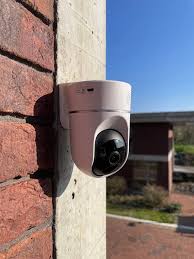
- Key Features:
- 2K resolution with pan and tilt functionality
- AI-powered motion detection
- IP67 weatherproof rating
- 2-way audio
- No monthly subscription fees
- Best For: Those who want a camera with advanced motion detection and flexibility in outdoor positioning.
- Price Range: $99 – $129
6. Logitech Circle View
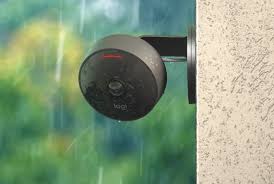
- Key Features:
- 1080p video with HDR
- Wide 180° field of view
- Built-in siren
- IP64 weatherproof rating
- HomeKit Secure Video support
- Best For: Apple HomeKit users seeking a high-quality weatherproof camera with a wide field of view.
- Price Range: $159 – $199
7. Blink Outdoor
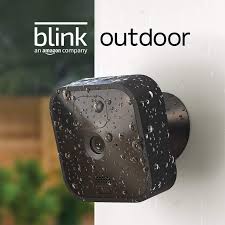
- Key Features:
- 1080p HD video
- Motion detection with alerts
- Weather-resistant (IP65 rating)
- Battery-powered
- Two-year battery life
- Best For: Users who want a reliable, budget-friendly outdoor camera with long battery life.
- Price Range: $99 – $119
8. Reolink Argus 3 Pro
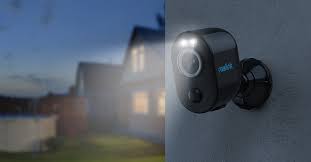
- Key Features:
- 4MP Super HD video
- Built-in spotlight and color night vision
- Weatherproof (IP65 rating)
- Battery-powered or solar-powered option
- Flexible placement
- Best For: Users looking for a high-definition, solar-powered outdoor camera that provides clear video quality day or night.
- Price Range: $139 – $169
9. Amcrest 4K UltraHD Outdoor Camera
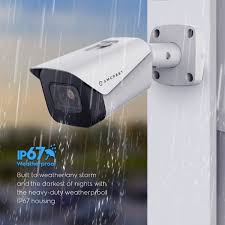
- Key Features:
- 4K resolution
- Wide dynamic range (WDR)
- IP67 weatherproof rating
- Motion detection alerts
- 2-way audio
- Best For: People who need ultra-high-definition surveillance in all weather conditions.
- Price Range: $199 – $229
10. Swann 4K Ultra HD Security Camera
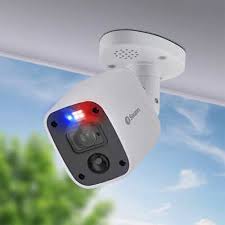
- Key Features:
- 4K resolution with wide-angle view
- Motion detection with activity zones
- IP66 weatherproof rating
- Color night vision
- 2-way audio
- Best For: Users looking for advanced surveillance with the best video quality and extensive outdoor protection.
- Price Range: $180 – $250
Why Weatherproof Cameras Matter:
Weatherproof cameras are designed to withstand harsh conditions such as rain, snow, and extreme temperatures. For outdoor use, cameras need to have an IP (Ingress Protection) rating of at least IP65 or higher to ensure they are fully protected against dust and rain. Additionally, they should have wide temperature tolerance to prevent malfunctions in extreme weather.
Choosing the Best Weatherproof Camera for Your Needs:
Consider the following factors when choosing a weatherproof camera:
- Video Resolution: Higher resolution cameras (like 2K or 4K) provide clearer footage, especially for identifying faces or license plates.
- Field of View: A wider field of view allows you to cover more area with a single camera.
- Connectivity & Integration: Look for cameras that are compatible with smart home systems such as Alexa, Google Assistant, or Apple HomeKit.
- Power Source: Choose between battery-powered, wired, or solar-powered options depending on your needs and the availability of power sources.
Additional Tips for Maintaining Your Security Cameras
Regular Camera Maintenance
- Cleaning Tips to Prevent Buildup of Moisture and Dirt on Lenses:
To keep your camera clear of moisture and dirt, regular cleaning is essential. Use a microfiber cloth to wipe the camera lens and housing, avoiding harsh chemicals that could damage the surface. Check the camera housing for any cracks or gaps that could let moisture in. Consider using lens cleaning solutions or wipes specifically designed for cameras.
Investing in Quality Camera Enclosures
- Importance of High-Quality Housing for Outdoor Cameras:
When purchasing an enclosure, ensure it is built to withstand environmental challenges, including moisture, dust, and temperature fluctuations. A high-quality housing will offer a long-lasting solution to prevent fog and will protect the internal components of the camera. - Materials That Offer Better Protection Against Fog and Weather Conditions:
Look for enclosures made of high-quality materials like aluminum or stainless steel, which are durable and resistant to rust and corrosion. Additionally, enclosures with proper ventilation help to reduce condensation buildup. Some enclosures also come with built-in heaters or fans, which can further help with temperature regulation inside the camera casing.
Comparison Table – Best Anti-Fog Solutions for Security Cameras
| Solution | Effectiveness | Ease of Use | Price | Best For |
| Anti-Fog Filters | High | Easy | $10-$30 | Quick solution |
| Dehumidifiers | Medium | Moderate | $50-$200 | Long-term solution |
| Weatherproof Casing | High | Moderate | $20-$100 | Extreme conditions |
FAQ’s and Queries about How to Prevent Fog on Security Camera
What are the best anti-fog spray for security camera?
The best anti-fog sprays are designed to create a protective layer on the lens to prevent moisture build-up. Look for sprays like Cat Crap Anti-Fog Spray or Anti-Fog Lens Cleaner. These sprays are easy to apply and work well for preventing fog on lenses during both daytime and nighttime conditions. Be sure to choose sprays that are safe for camera lenses and don’t leave a residue.
How to Prevent Fog on Security Camera at Night?
At night, temperature drops can cause condensation to form on the camera lens. Here are some tips to prevent fogging:
- Use a Heating Element: Install a small heater or dehumidifier inside the camera enclosure. This will maintain the temperature inside the casing and prevent condensation.
- Anti-Fog Gel or Filter: Use anti-fog gel pads or filters inside the camera housing. These absorb moisture and help maintain a clear lens.
- Ensure Proper Ventilation: Avoid placing cameras in areas with poor airflow. Proper ventilation helps stabilize temperature changes and reduces the likelihood of fogging.
How to Prevent Fog on Security Camera Reddit?
On Reddit, users suggest several practical solutions for preventing fog on security cameras, including:
- Using Silica Gel Packs: Many users recommend placing silica gel packets inside the camera housing to absorb moisture and prevent fog.
- Applying Anti-Fog Sprays: Anti-fog sprays are a common solution shared by Redditors to keep cameras clear, especially in areas with high humidity.
- Choosing the Right Camera Placement: Properly positioning the camera away from heat sources and ensuring it’s protected from direct weather exposure can significantly reduce fogging.
How to Keep Outdoor Security Cameras from Fogging Up?
To prevent your outdoor security cameras from fogging up:
- Install a Dehumidifier: Place a small dehumidifier near your camera, or consider a camera housing that allows you to integrate one.
- Ensure Proper Sealing: Make sure the camera’s housing is tightly sealed to prevent moisture from entering.
- Consider an All-Weather Camera: Some cameras are designed with fog-resistant features, such as the Arlo Pro 4 or Ring Stick Up Cam, which are built to withstand all types of weather, including fog and condensation.
How to Prevent Security Camera Lens from Fogging at Night?
To avoid fogging at night:
- Use a Camera Heater: Small, low-power heaters or heat pads inside the camera housing will help prevent the lens from cooling too quickly and forming condensation.
- Prevent Direct Contact with Cold Surfaces: Avoid mounting the camera on cold surfaces like metal or glass, as these can cause rapid temperature changes and condensation.
Anti-Fog for Security Cameras
Anti-fog solutions for security cameras typically include sprays, filters, and gel pads. These solutions work by forming a barrier on the lens to stop moisture from accumulating. Be sure to choose a product that is safe for camera lenses and does not degrade the image quality.
Security Camera Foggy at Night
If your security camera is foggy at night, it’s often due to a combination of cool outdoor temperatures and moisture. To prevent this, you can use one of the following methods:
- Apply an anti-fog spray or use an anti-fog filter.
- Use a dehumidifier inside the camera’s housing or case.
- Install a small heating element or lens heater to maintain a consistent temperature inside the housing.
How to Keep Cameras from Fogging Up
To keep your cameras from fogging up:
- Ensure Proper Sealing and Ventilation: Proper sealing of the camera housing keeps moisture out, and ventilation helps balance the temperature inside and outside the camera case.
- Use Silica Gel or Desiccants: Placing silica gel packs inside the camera enclosure will absorb moisture and prevent fogging.
- Install an Anti-Fog Lens Coating or Filter: This is one of the most effective ways to prevent fog buildup on the lens.
Outdoor Cams Foggy / Condensation After Rain – Cameras
When cameras fog up or accumulate condensation after rain, it’s typically because of moisture seeping into the camera housing. To solve this issue:
- Ensure Waterproofing: Use IP-rated enclosures that provide complete protection against water and condensation.
- Consider an Integrated Dehumidifier: Some outdoor camera enclosures come with built-in dehumidifiers to absorb excess moisture.
Problem with the Outdoor Camera Lens Frosting Over and/or Water Droplets
Lens frosting and water droplets can occur due to the temperature difference between the inside and outside of the camera housing. To prevent this:
- Use Anti-Fog Solutions: Applying anti-fog spray, gel, or using an anti-fog filter will help keep the lens clear.
- Proper Camera Housing: Make sure your camera has a sealed, weatherproof case that keeps out water and maintains temperature balance.
How Do I Stop This Ring Camera Fogging Up?
For Ring cameras specifically:
- Use Silica Gel Packs: Place small silica gel packets inside the Ring camera housing to absorb moisture.
- Apply Anti-Fog Spray: Lightly apply an anti-fog spray to the lens.
- Check for Gaps: Ensure the camera’s housing is sealed properly and no moisture can enter.
How Do You Guys Stop Cameras from Fogging, Condensating?
Many users recommend a combination of strategies:
- Anti-Fog Sprays or Filters: These products prevent moisture buildup on the camera lens.
- Silica Gel Packs: They absorb excess moisture in the camera housing.
- Camera Placement: Position the camera in a location with good ventilation and temperature regulation.
How to Keep a Security Camera from Fogging Up?
To stop a security camera from fogging up:
- Install a Weatherproof Case: Ensure your camera is housed in a high-quality, weather-resistant case.
- Use Silica Gel or Anti-Fog Filters: Use silica gel packets or anti-fog filters inside the enclosure to reduce moisture buildup.
- Proper Ventilation and Sealing: Ensure the camera is placed in an area with good airflow and that the housing is tightly sealed to prevent moisture from entering.
How Do I Make My Camera Not Foggy?
To prevent your camera from fogging up, follow these steps:
- Use Anti-Fog Coatings: Apply a fog-resistant coating to the lens.
- Install Dehumidifiers or Silica Gel: These will absorb moisture inside the housing and reduce condensation.
- Mount the Camera Properly: Ensure the camera is installed in a location where temperature fluctuations are minimized.
How to Prevent Dew on Camera?
Dew can form when temperature differences cause moisture to condense on the camera lens. To prevent dew formation:
- Use Anti-Fog Solutions: Use sprays or filters designed to reduce moisture buildup on the lens.
- Camera Housing with Built-in Heating: Consider using a camera housing with a small heating element to maintain a consistent temperature.
Why Does My Outside Camera Look Foggy?
Fog on an outside camera is usually caused by environmental factors like humidity, temperature fluctuations, or condensation. To solve this, apply anti-fog solutions, use silica gel packs inside the housing, and ensure your camera is properly sealed and ventilated.
Conclusion
Fog on security cameras can significantly compromise the clarity of your surveillance footage, putting your safety and security at risk
Implement one of the solutions today to ensure your cameras perform at their best year-round. For the best camera options, browse our top picks and start improving your surveillance setup today.

